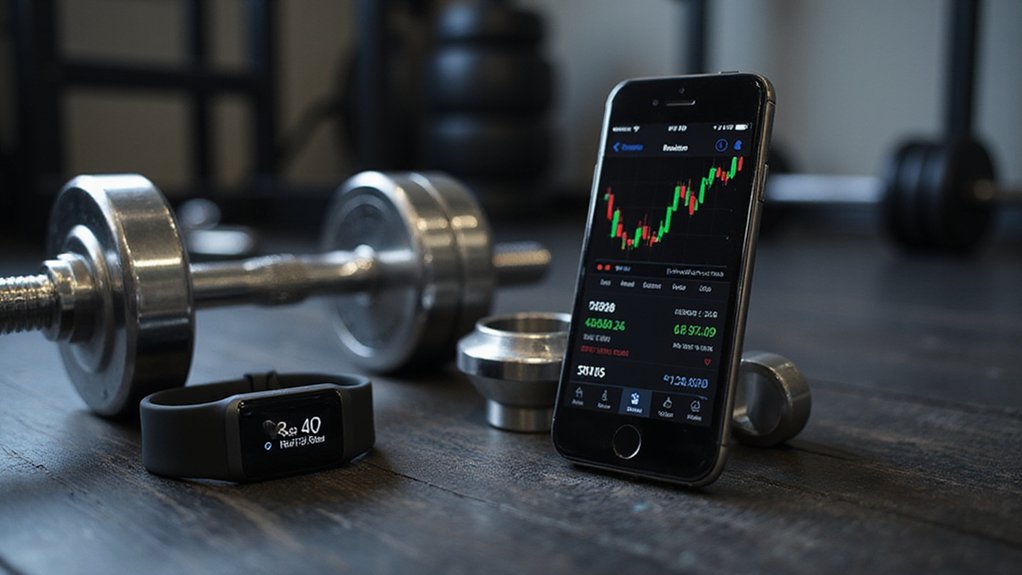The Gigachad cryptocurrency has somehow parlayed a digitally-enhanced fitness meme into a $700 million Solana-based ecosystem that bridges internet masculinity culture with actual wellness products. Launched in 2024 with 9.6 billion circulating tokens, this dual-token system enables community governance over both cryptocurrency developments and the accompanying Giga Fitness luxury brand—complete with endorsements from bodybuilding personalities like Mike O’Hearn. The convergence reveals fascinating dynamics between digital assets and physical commerce.

How does a Russian bodybuilder’s photoshopped physique translate into a $700 million cryptocurrency empire that somehow spawns its own luxury fitness brand? The answer lies in Gigachad (GIGA), a Solana-based meme coin that launched in early 2024 and achieved what most traditional fitness companies spend decades attempting to build.
Ernest Khalimov’s digitally enhanced jawline became the foundation for a cryptocurrency ecosystem that transcends typical meme coin boundaries. With 9.6 billion tokens circulating from a 10-billion supply, GIGA operates on Solana’s infrastructure—capitalizing on the network’s low fees and transaction speed to facilitate both speculative trading and legitimate utility functions.
The project’s genius lies in its seamless integration of internet culture with tangible business applications. While most meme coins rely solely on community hype and celebrity endorsements (Mike “Titan” O’Hearn and Paulo Costa provide the requisite social media validation), Gigachad extends into Giga Fitness, a luxury wellness brand that transforms digital masculinity into physical products and services.
This dual-token ecosystem creates fascinating economic dynamics. Holders can stake tokens for rewards while participating in decentralized governance decisions—essentially voting on both cryptocurrency developments and fitness brand direction. The community-driven model eliminates centralized ownership, theoretically ensuring that token holders directly influence both digital asset performance and lifestyle brand evolution.
What distinguishes Gigachad from countless other Solana meme coins is its cultural foundation. The 2017 meme’s evolution from internet joke to symbol of “alpha masculinity” provides legitimate brand recognition that fitness enthusiasts actually understand and embrace. Rather than relying purely on speculative trading, the project leverages existing community values around self-improvement and discipline. The character Ernest Khalimov was originally created by fitness photographer Christa Sudmalis, establishing an authentic connection to the fitness industry from its inception.
The market responded predictably: early reports noted modest $176,000 valuations before explosive growth pushed market capitalization beyond $700 million within months. This trajectory reflects broader meme coin trends where cultural resonance translates into substantial financial returns, particularly when projects offer utility beyond speculative trading. Similar to other successful Solana projects like PONKE, which features PonkeSwap for efficient token trading, ecosystem expansion often drives sustainable growth beyond initial hype. Major exchanges including Coinbase, Kraken, and KuCoin facilitate GIGA trading across over 100 countries, though access restrictions apply to certain regions like New York.
Whether Gigachad’s fitness integration represents sustainable business development or elaborate marketing remains unclear, but the project successfully demonstrates how internet culture, blockchain technology, and lifestyle branding can converge into unexpectedly profitable ventures.
Frequently Asked Questions
How Do I Start Earning Cryptocurrency Through Fitness Tracking Apps?
One downloads established fitness applications like ActFit or FitCoin, syncs wearable devices or smartphone sensors, then maintains consistent daily activity targets—typically 5,000-10,000 steps for maximum token accumulation.
These platforms reward physical exertion with proprietary cryptocurrencies (AFIT tokens) or established assets like Bitcoin and Ethereum.
Users maximize earnings through marketplace participation, prediction games, and strategic conversion timing, though the irony of monetizing basic human movement remains delightfully absurd in our increasingly financialized existence.
Which Crypto Wallets Are Best for Storing Fitness-Earned Tokens?
For fitness-earned tokens, hardware wallets like Ledger or Trezor provide superior security for long-term holdings, while MetaMask offers superior convenience for active trading and dApp integration.
Most fitness tokens operate on Ethereum (supporting ERC-20 standards) or Polygon networks.
Exchange wallets, though tempting for their simplicity, expose users to platform risks—a rather unfortunate irony given fitness apps supposedly promote personal empowerment and control over one’s digital assets.
Can I Lose My Earned Crypto if the Fitness Platform Shuts Down?
Platform shutdowns pose genuine risks to fitness-earned tokens, particularly when stored on centralized exchanges or within the platform’s proprietary wallet system.
Smart users transfer rewards to hardware wallets immediately—a practice that transforms speculative fitness gamification into actual asset ownership.
While community-backed tokens like GIGA benefit from decentralized governance structures, relying solely on platform storage effectively transforms one’s workout achievements into digital IOUs of questionable permanence.
What Are the Tax Implications of Earning Cryptocurrency Through Workouts?
Cryptocurrency earned through workouts constitutes taxable income—not capital gains—subjecting earners to rates spanning 10% to 37% based on total income.
The IRS values these digital rewards at fair market value upon receipt, requiring meticulous record-keeping for Form 1040 reporting.
Self-employment taxes may apply if workout activities constitute business operations.
Given the regulatory complexity (and the inherent absurdity of explaining sweat equity in digital assets), professional tax consultation remains prudent.
How Much Cryptocurrency Can Realistically Be Earned per Workout Session?
Realistic cryptocurrency earnings per workout session remain disappointingly modest—Sweatcoin typically rewards pennies worth of tokens per thousand steps, while StepN users might earn $1-5 per session (depending on NFT sneaker ownership and energy allocation).
These microtransactions hardly constitute meaningful income, though market volatility can occasionally inflate token values.
The brutal reality? Users earn more from avoiding premium gym memberships than from their digital fitness tokens.









